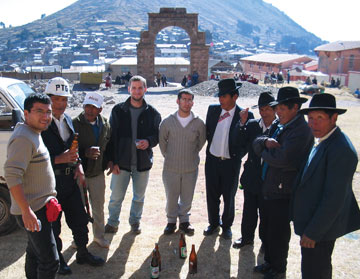|
NEWS NOTES
Genetics supports one main migration to Americas
 Noah Rosenberg |
| Researchers compared DNA from 29 native populations across the Americas, including in Peru, to 49 other ethnic groups from around the world to determine migration patterns into the Americas. |
A new extensive genetic analysis is adding pieces to the long-standing puzzle about how and when humans first populated the Americas, suggesting the Western Hemisphere was first inhabited by one main wave of immigrants that left Siberia and then traveled along coasts through the Americas.
An international team of researchers analyzed the genetics of 29 Native American populations from across the Americas and compared them to 49 other groups from elsewhere in the world. The researchers, who reported the findings in the November PLoS Genetics, looked at 678 different “microsatellite markers” — genetic fingerprints left by ancient relatives that scientists can still detect today.
Microsatellites are regions of the human genome that contain short repeated DNA sequences. Individuals differ in the number of recurring units they have, says Noah Rosenberg of the University of Michigan in Ann Arbor, a co-author of the study. “For example, there may be a sequence that is repeated 15 times in one individual and 18 times in another individual. We can use this difference in the number of copies as a measurement of how genetically similar or different two individuals are,” Rosenberg says.
The team’s analysis shows that within the Americas, from north to south, there is a decline in genetic similarity to modern Siberians. There is also a decline in genetic diversity with distance from the Bering Strait. Together, this points to a common source region in Siberia, Rosenberg says. If a subset of a certain population migrates to a new location, it only carries with it a fraction of the diversity of its ancestral population. “If you imagine a process in which subsets of populations sequentially migrated from their ancestral homeland farther into the Americas, then the farther into the Americas we look, the lower the level of genetic diversity we expect. And that’s exactly what we observe,” he says.
These results support the main hypothesis for how and when people first migrated to the Americas: Most of the continent’s ancestry derives from a small group of people who wandered from Siberia over a land bridge, called Beringia, which existed during the last ice age more than 12,000 years ago. One variation of that hypothesis suggests that ancient people traveled into the Americas along the coast, across the Bering land bridge to Alaska and then down the western coast of British Columbia into the Pacific Northwest, Rosenberg says. Coastal migration has recently been suggested as a possible explanation for how early American archaeological sites are distributed, and this study turned up genetic evidence supporting these hypotheses, he says. For example, the team’s analyses showed that a coastal route provided a slightly better fit for the pattern of genetic diversity than an inland path.
The team also investigated a particular genetic variant that was widely distributed in every population throughout the Americas, but that was absent everywhere else in the world except in two populations at the far eastern edge of Siberia. “We find it difficult to explain the distribution of this particular private variant unless we assume that migrations from the same original source were responsible for most of the genetic ancestry of the populations in the Americas today,” Rosenberg says, further supporting the notion that humans came to the Americas in one main migration rather than in several.
The study is significant because it is one of the first to look at such a broad sample of DNA locations within the nuclear genome, says David Smith of the University of California at Davis, who has studied migration patterns into the Americas. “Microsatellites are very informative and highly useful for this kind of study,” he says.
“This is a significant paper that addressed several of the principal questions that people have posed about the settlement of the New World,” Smith says. The “authors’ conclusions are convincing,” he says. Recent technological advances and a stronger emphasis on large collaborations make projects such as this possible, he adds. “I think this is just the tip of the iceberg of what we are going to see emerging in the next few years in terms of large genomic studies.”
Links:
"The Ice-Free Corridor Revisited," Geotimes, February 2004
"Quest for the Lost Land," Geotimes, February 2004
"Warming opened Americas to humans," Geotimes, June 2006

 Subscribe
Subscribe


